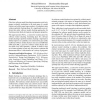1406 search results - page 120 / 282 » Similarity in Programs |
BMCBI
2008
14 years 10 months ago
2008
Background: It has repeatedly been shown that interacting protein families tend to have similar phylogenetic trees. These similarities can be used to predicting the mapping betwee...
CAV
2009
Springer
15 years 10 months ago
2009
Springer
We present HOMER, an observational-equivalence model checker for the 3rd-order fragment of Idealized Algol (IA) augmented with iteration. It works by first translating terms of the...
ICFP
2004
ACM
15 years 10 months ago
2004
ACM
Useful type inference must be faster than normalization. Otherwise, you could check safety conditions by running the program. We analyze the relationship between bounds on normali...
OOPSLA
2010
Springer
14 years 8 months ago
2010
Springer
Glass box software model checking incorporates novel techniques to identify similarities in the state space of a model checker and safely prune large numbers of redundant states w...
102
click to vote
JAR
2010
14 years 4 months ago
2010
Nominal logic is a variant of first-order logic with special facilities for reasoning about names and binding based on the underlying concepts of swapping and freshness. It serves ...

